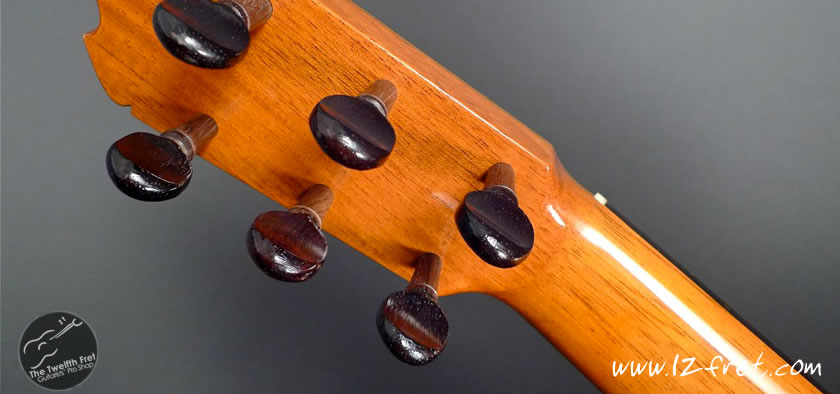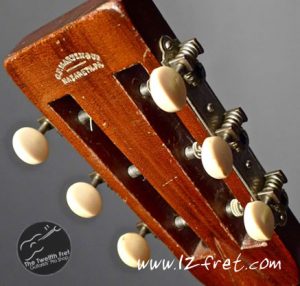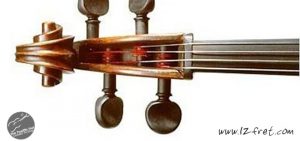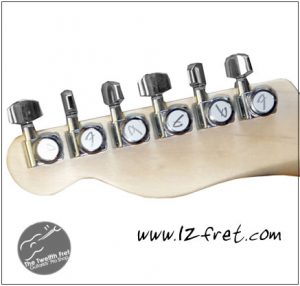Traditionally, tapered friction tuning pegs made of hard wood were carefully fitted into matching holes on the headstock. This is still the case with violin family instruments and traditional Flamenco guitars. However, as metal working techniques improved during the Industrial Revolution mass-produced reliable tuning gears or “machine heads” appeared, offering easier and more accurate adjustment.

- Tuning Machines – the Twelfth Fret
Tuners and Tuning Machines
Friction Tuners
You’ll recognise a friction tuner right away – they are the standard part on any violin. They are made of hard, stable dense wood like ebony. They have a taper that fits into a hole with matching taper. When tuning, it’s necessary to push and turn to keep the peg from moving outwards, losing friction, and slipping back as soon as it’s released. Peg Dope is used to provide both lubrication and friction.
Faux Friction Pegs – The PegHed
Friction pegs are pretty much required on traditional bowed or Flamenco instruments, but they have practical drawbacks. Enter the PegHed, designed to replace a true friction peg with little or no modification. The PegHed looks like a friction peg, but contains a patented planetary gearing mechanism.

Geared Tuners
There is a wide range of tuning gear designs for the needs of different instruments. But all geared tuning machines have the same set of parts – a capstan or post that the string wraps around, a pinion and worm gear set, and a button to hold onto. There are six basic styles: for nylon or steel strings, closed or open gear, and plate mounted or single gear. There is one feature that all gear sets have – a gear ratio, and that’s the number of turns of the button needed for one turn of the capstan.
The difference between nylon and steel string tuners is the size of the capstan. For nylon strings, the capstan is up to 3/8 inches or 10mm diameter, and usually made of plastic. For steel strings, it’s about half the diameter and metal. On solid peghead steel string guitars, there’s also a bushing to support the capstan as it comes out of the front of the head.
Open tuners expose the pinion and worm gears, allowing lubrication and disassembly. Closed gears have a housing around the gear set, with permanent lubrication inside.
Plate-mounted units contain several tuners and are used on classical guitars and mandolins of all price ranges. With steel string guitars, unless it’s a vintage style reproduction, plate tuners are usually found on lower cost models. The plate mount adds support to the gears and reduce installation work and the number of mounting holes drilled in the headstock.
Individual tuners allow flexibility in placement and the number of gears installed, helpful for instruments like 5-string basses or 7-string guitars, or with curved head shapes.
There are a few variations on these basic elements to adapt to instrument design. Headless guitars like the Steinberger or Dan Erlewine’s Lazer guitars, or locking tremolo systems add a tension adjuster into the bridge. The string is pulled back rather than wrapped around a capstan.
Locking Tuners
Recently, a new style of tuner has appeared, aimed at guitars with non-locking tremolo bridges but Locking Tuners have proven to be useful on any guitar. The lock is in the capstan. You loosen a thumbwheel, insert the string and pull it taut, then tighten the thumbwheel and turn the tuner button to bring the string to pitch with a couple of turns. Changing strings and tuning is much faster, and this is very helpful if you play for a living.
Which Way To Install a Tuner?
Tuners are normally installed so that the tension on the capstan tends to pull the gear set together. This usually means that the capstan is closer to the nut than the gears.
How To Wrap Strings on a Tuner?
Strings should be wrapped so that they don’t pull out of the tuner, but don’t over-wrap, and leave as straight a path to the nut as possible. On nylon string guitars, a simple knot is helpful to keep the strings from pulling out as tension increases. Push the string through the capstan hole, then wrap it backwards and loop it under the string. As the string tightens, the loop will be clamped and not slip.
On solid peghead guitars, the strings normally leave the capstan edge that faces the center of the headstock.
Are my tuning gears broken? Should I replace them?
While it is possible for gears to wear out or become damaged, modern gears of all types are reliable. But, some gears are smoother or have a higher ratio, or just look better.
A common complaint at the repair desk is that a tuner isn’t working, because turning the gear doesn’t do anything and suddenly results in a ping and jump in pitch. This isn’t the tuner, it’s the string sticking in the nut!
String Winders
String or Peg Winders are a common and helpful accessory. It’s a simple crank that fits over the tuner button, and lets you turn the button and bring the string to tension quickly. Over time, this can save you days. As a bonus, winders often have a notch to help lever out bridge pins on acoustic guitars.
Patrick Keenan – The Twelfth Fret



